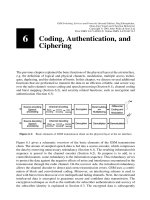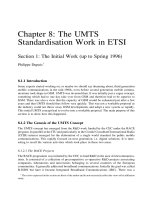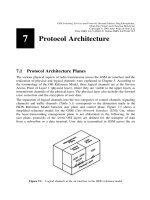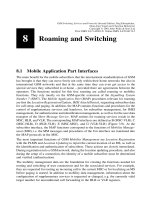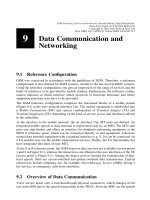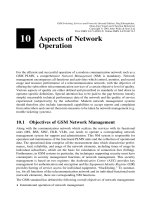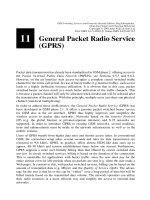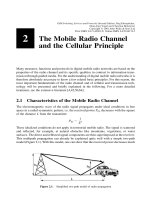GSM switching services and protocols P8
Bạn đang xem bản rút gọn của tài liệu. Xem và tải ngay bản đầy đủ của tài liệu tại đây (829.66 KB, 27 trang )
Roaming and Switching
8.1 Mobile Application Part Interfaces
The main bene®t for the mobile subscribers that the international standardization of GSM
has brought is that they can move freely not only within their home networks but also in
international GSM networks and that at the same time they can even get access to the
special services they subscribed to at home ± provided there are agreements between the
operators. The functions needed for this free roaming are called roaming or mobility
functions. They rely mostly on the GSM-speci®c extension of the Signalling System
Number 7 (SS#7). The Mobile Application Part (MAP) procedures relevant for roaming
are ®rst the Location Registration/Update, IMSI Attach/Detach, requesting subscriber data
for call setup, and paging. In addition, the MAP contains functions and procedures for the
control of supplementary services and handover, for subscriber management, for IMEI
management, for authentication and identi®cation management, as well as for the user data
transport of the Short Message Service. MAP entities for roaming services reside in the
MSC, HLR, and VLR. The corresponding MAP interfaces are de®ned as B (MSC-VLR), C
(MSC-HLR), D (HLR-VLR), E (MSC-MSC), and G (VLR-VLR) (Figure 3.9). At the
subscriber interface, the MAP functions correspond to the functions of Mobility Manage-
ment (MM), i.e. the MM messages and procedures of the Um interface are translated into
the MAP protocols in the MSC.
The most important functions of GSM Mobility Management are Location Registration
with the PLMN and Location Updating to report the current location of an MS, as well as
the identi®cation and authentication of subscribers. These actions are closely interrelated.
During registration into a GSM network, during the location updating procedure, and also
during the setup of a connection, the identity of a mobile subscriber must be determined
and veri®ed (authentication).
The mobility management data are the foundation for creating the functions needed for
routing and switching of user connections and for the associated services. For example,
they are requested for routing an incoming call to the current MSC or for localizing an MS
before paging is started. In addition to mobility data management, information about the
con®guration of supplementary services is requested or changed, e.g. the currently valid
target number for unconditional call forwarding in the HLR or VLR registers.
8
GSM Switching, Services and Protocols: Second Edition. Jo
È
rg Eberspa
È
cher,
Hans-Jo
È
rg Vo
È
gel and Christian Bettstetter
Copyright q 2001 John Wiley & Sons Ltd
Print ISBN 0-471-49903-X Online ISBN 0-470-84174-5
8.2 Location Registration and Location Update
Before a mobile station can be called or gets access to services, the subscriber has to
register with the mobile network (PLMN). This is usually the home network where the
subscriber has a service contract. However, the subscriber can equally register with a
foreign network provider in whose service area he or she is currently visiting, provided
there is a roaming agreement between the two network operators. Registration is only
required if there is a change of networks, and therefore a VLR of the current network has
not yet issued a TMSI to the subscriber. This means the subscriber has to report to the
current network with his IMSI and receives a new TMSI by executing a Location Regis-
tration procedure. This TMSI is stored by the MS in its nonvolatile SIM storage, such that
even after a powerdown and subsequent power-up only a normal Location Updating
procedure is required.
The sequence of operations for registration is presented schematically in Figure 8.1. After
a subscriber has requested registration at his or her current location by sending a location
update request with his or her IMSI and the current location area (LAI), ®rst the MSC
instructs the VLR with a MAP message update location area to register the MS with its
current LAI. In order for this registration to be valid, the identity of the subscriber has to be
checked ®rst, i.e. the authentication procedure is executed. For this purpose, the authenti-
cation parameters have to be requested from the AUC through the HLR. The precalculated
sets of security parameters (Kc, RAND, SRES) are usually not transmitted individually to
the respective VLR. In most cases, several complete sets are kept at hand for several
authentications. Each set of parameters, however, can only be used once, i.e. the VLR
must continually update its supply of security parameters (authentication parameter
request).
After successful authentication (see Section 6.3.2), the subscriber is assigned a new
MSRN, which is stored with the LAI in the HLR, and a new TMSI is also reserved for
this subscriber; this is TMSI Reallocation (see Figure 7.25). To encrypt the user data, the
base station needs the ciphering key Kc, which it receives from the VLR by way of the
MSC with the command start ciphering. After ciphering of the user data has begun, the
TMSI is sent in encrypted form to the mobile station. Simultaneously with the TMSI
assignment, the correct and successful registration into the PLMN is acknowledged (loca-
pdate accept). Finally, the mobile station acknowledges the correct reception of the
TMSI (tmsi reallocation complete, see Figure 7.26).
While the location information is being updated, the VLR is obtaining additional informa-
tion about the subscriber, e.g. the MS category or con®guration parameters for supple-
mentary services. For this purpose, the Insert Subscriber Data Procedure is de®ned
(insert subscriber data message in Figure 8.1). It is used for registration or location
updating in the HLR to transmit the current data of the subscriber pro®le to the VLR. In
general, this MAP procedure can always be used when the pro®le parameters are changed,
e.g. if the subscriber recon®gures a supplementary service such as unconditional forward-
ing. The changes are communicated immediately to the VLR with the Insert Subscriber
Data Procedure.
The location update procedure is executed, if the mobile station recognizes by reading the
LAI broadcast on the BCCH that it is in a new location area, which leads to updating the
8 Roaming and Switching
182
location information in the HLR record. Alternatively, the location update can also occur
periodically, independent of the current location. For this purpose, a time interval value is
broadcast on the BCCH, which prescribes the time between location updates. The main
objective of this location update is to know the current location for incoming calls or short
messages, so that the call or message can be directed to the current location of the mobile
station. The difference between the location update procedure and the location registration
procedure is that in the ®rst case the mobile station has already been assigned a TMSI. The
8.2 Location Registration and Location Update
183
Figure 8.1: Overview of the location registration procedure
TMSI is unique only in connection with an LAI, and both are kept together in the non-
volatile storage of the SIM card. With a valid TMSI, the MS also keeps a current ciphering
key Kc for encryption of user data (Figure 8.2), although this key is renewed during the
location update procedure. This key is recalculated by the MS based on the random
number RAND used for authentication, whereas on the network side it is calculated in
the AUC and made available in the VLR.
Corresponding to the location update procedure, there is an MM procedure at the air
interface of the MM-category speci®c. Besides the location updating proper, it contains
three blocks which are realized at the air interface by three procedures of the category
common (see Figure 7.26): the identi®cation of the subscriber, the authentication, and the
start of ciphering on the radio channel. In the course of location updating, the mobile
station also receives a new TMSI, and the current location is updated in the HLR. Figure
8.2 illustrates the standard case of a location update. The MS has entered a new LA, or the
timer for periodic location updating has expired, and the MS requests to update its location
information. It is assumed that the new LA still belongs to the same VLR as the previous
8 Roaming and Switching
184
Figure 8.2: Overview of the location updating procedure
one, so only a new TMSI needs to be assigned. This is the most frequent case. But if its not
quite so crucial to keep the subscriber identity con®dential, it is possible to avoid assigning
a new TMSI. In this case, only the location information is updated in the HLR/VLR.
The new TMSI is transmitted to the MS in enciphered form together with the acknow-
ledgement of the successful location update. The location update is complete after
acknowledgement by the mobile station. After execution of the authentication, the VLR
can complete its database and replace the ``consumed'' 3-tuple (RAND, SRES, Kc) by
another one requested from the HLR/AUC.
If location change involves both LA and VLR, the location update procedure is somewhat
more complicated (Figure 8.3). In this case, the new VLR has to request the identi®cation
and security data for the MS from the old VLR and store them locally. Only in emergency
cases, if the old VLR cannot be determined from the old LAI or if the old TMSI is not
known in the VLR, the new VLR may request the IMSI directly from the MS (identi®ca-
tion procedure). Only after a mobile station has been identi®ed through the IMSI from the
old VLR and after the security parameters are available in the new VLR, is it possible for
the mobile station to be authenticated and registered in the new VLR, for a new TMSI to be
assigned, and for the location information in the HLR to be actualized. After successful
registration in the new VLR (location update accept) the HLR instructs the old VLR to
cancel the invalid location data in the old VLR (cancel location).
In the examples shown (Figures 8.1±8.3), the location information is stored as MSRN in
the HLR. The MSRN contains the routing information for incoming calls and this infor-
8.2 Location Registration and Location Update
185
Figure 8.3: Location update after changing the VLR area
mation is used to route incoming calls to the current MSC. In this case, the HLR receives
the routing information already at the time of the location update. Alternatively, at location
update time, the HLR may just store the current MSC and/or VLR number in connection
with an LMSI, such that routing information is only determined at the time of an incoming
call.
8.3 Connection Establishment and Termination
8.3.1 Routing Calls to Mobile Stations
The number dialed to reach a mobile subscriber (MSISDN) contains no information at all
about the current location of the subscriber. In order to establish a complete connection to a
mobile subscriber, however, one must determine the current location and the locally
responsible switch (MSC). In order to be able to route the call to this switch, the routing
address to this subscriber (MSRN) has to be obtained. This routing address is assigned
temporarily to a subscriber by its currently associated VLR. At the arrival of a call at the
GMSC, the HLR is the only entity in the GSM network which can supply this information,
and therefore it must be interrogated for each connection setup to a mobile subscriber. The
principal sequence of operations for routing to a mobile subscriber is shown in Figure 8.4.
An ISDN switch recognizes from the MSISDN that the called subscriber is a mobile
subscriber, and therefore can forward the call to the GMSC of the subscriber's home
PLMN based on the CC and NDC in the MSISDN (1). This GMSC can now request the
current routing address (MSRN) for the mobile subscriber from the HLR using the MAP
(2,3). By way of the MSRN the call is forwarded to the local MSC (4), which determines
the TMSI of the subscriber (5,6) and initiates the paging procedure in the relevant location
area (7). After the mobile station has responded to the paging call (8), the connection can
be switched through.
Several variants for determining the route and interrogating the HLR exist, depending on
how the MSRN was assigned and stored, whether the call is national or international, and
depending on the capabilities of the associated switching centers.
8.3.1.1 Effect of the MSRN Assignment on Routing
There are two ways to obtain the MSRN:
² obtaining the MSRN at location update
² obtaining the MSRN on a per call basis
For the ®rst variant, an MSRN for the mobile station is assigned at the time of each location
update which is stored in the HLR. This way the HLR is in a position to supply immedi-
ately the routing information needed to switch a call through to the local MSC.
The second variant requires that the HLR has at least an identi®cation for the currently
responsible VLR. In this case, when routing information is requested from the HLR, the
HLR ®rst has to obtain the MSRN from the VLR. This MSRN is assigned on a per call
basis, i.e. each call involves a new MSRN assignment.
8 Roaming and Switching
186
8.3.1.2 Placement of the Protocol Entities for HLR Interrogation
Depending on the capabilities of the associated switches and the called target (national or
international MSISDN), there are different routing procedures. In general, the local switch-
ing center analyzes the MSISDN. Due to the NDC, this analysis of the MSISDN allows the
separation of the mobile traf®c from other traf®c. The case that mobile call numbers are
integrated into the numbering plan of the ®xed network is currently not provided.
In the case of a national number, the local exchange recognizes from the NDC that the
number is a mobile ISDN number. The ®xed network and home PLMN of the called
subscriber reside in the same country. In the ideal case, the local switch can interrogate
the HLR responsible for this MSISDN (HLR in the home PLMN of the subscriber) and
obtain the routing information (Figure 8.5a). The connection can then be switched through
via ®xed connections of the ISDN directly to the MSC.
If the local exchange does not have the required protocol intelligence for the interrogation
of the HLR, the connection can be passed on preliminarily to a transit exchange, which
then assumes the HLR interrogation and routing determination to the current MSC (Figure
8.5b). If the ®xed network is not at all capable of performing an HLR interrogation, the
connection has to be directed through a GMSC. This GMSC connects through to the
current MSC (Figure 8.5c). For all three cases, the mobile station could also reside in a
foreign PLMN (roaming); the connection is then made through international lines to the
current MSC after interrogating the HLR of the home PLMN.
In the case of an international call number, the local exchange recognizes only the
international CC and directs the call to an International Switching Center (ISC). Then
the ISC can recognize the NDC of the mobile network and process the call accordingly.
Figures 8.6 and 8.7 show examples for the processing of routing information. An inter-
8.3 Connection Establishment and Termination
187
Figure 8.4: Principle of routing calls to mobile subscribers
national call to a mobile subscriber involves at least three networks: the country from
which the call originates; the country with the home PLMN of the subscriber, Home
PLMN (H-PLMN); and the country in which the mobile subscriber is currently roaming,
Visited PLMN (V-PLMN). The traf®c between countries is routed through ISCs. Depend-
ing on the capabilities of the ISC, there are several routing variants for international calls
to mobile subscribers. The difference is determined by the entity that performs the HLR
interrogation, resulting in differently occupied line capacities.
8 Roaming and Switching
188
Figure 8.5: Routing variants for national MSISDN
Figure 8.6: Routing for international MSISDN (HLR interrogation from ISC)
If the ISC performs the HLR interrogation, the routing to the current MSC is performed
either by the ISC of the originating call or by the ISC of the mobile subscriber's H-PLMN
(Figure 8.6). If no ISC can process the routing, again a GMSC has to get involved, either a
GMSC in the country where the call originates or the GMSC of the H-PLMN (Figure 8.7).
For the routing procedures explained here, it does not matter which kind of subscriber is
calling, i.e. the subscriber may be in the ®xed network or in the mobile network. However,
for calls from mobile subscribers, the HLR interrogation is usually performed at the local
exchange (MSC).
8.3.2 Call Establishment and Corresponding MAP Procedures
Call establishment in GSM at the air interface is similar to ISDN call establishment at the
user network interface (Q.931) [7]. The procedure is supplemented by several functions:
random access to establish a signaling channel (SDCCH) for call setup signaling, the
authentication part, the start of ciphering, and the assignment of a radio channel.
The establishment of a connection always contains a veri®cation of user identity (authen-
tication) independent of whether it is a mobile-originated call setup or a mobile-terminated
call setup. The authentication is performed in the same way as for location updating. The
VLR supplements its database entry for this mobile station with a set of security data,
which replaces the ``consumed'' 3-tuple (RAND, SRES, Kc). After successful authentica-
tion, the ciphering process for the encryption of user data is started.
8.3.2.1 Outgoing Connection Setup
For outgoing connection setup (Figure 8.8), ®rst the mobile station announces its connec-
8.3 Connection Establishment and Termination
189
Figure 8.7: Routing through GMSC for international MSISDN
tion request to the MSC with a setup indication message, which is a pseudo-message. It
is generated between the MM entity of the MSC and the MAP entity, when the MSC
receives the message cm-service request from the MS, which indicates in this way the
request for an MM connection (see Figure 7.27). Then the MSC signals to the VLR that the
mobile station identi®ed by the temporary TMSI in the location area LAI has requested
service access (process access request) which is an implicit request for a random
number RAND from the VLR, to be able to start the authentication of the MS. This random
number is transmitted to the mobile station, its response with authentication result SRES is
returned to the VLR, which now examines the authenticity of the mobile station's identity
(compare authentication at registration, Figure 8.1).
After successful authentication, the ciphering process is started on the air interface, and
this way the MM connection between MS and MSC has been completely established (cm-
service accept). Subsequently, all signaling messages can be sent in encrypted form.
Only now the MS reports the desired calling target. While the MS is informed with a call
8 Roaming and Switching
190
Figure 8.8: Overview of outgoing call setup
